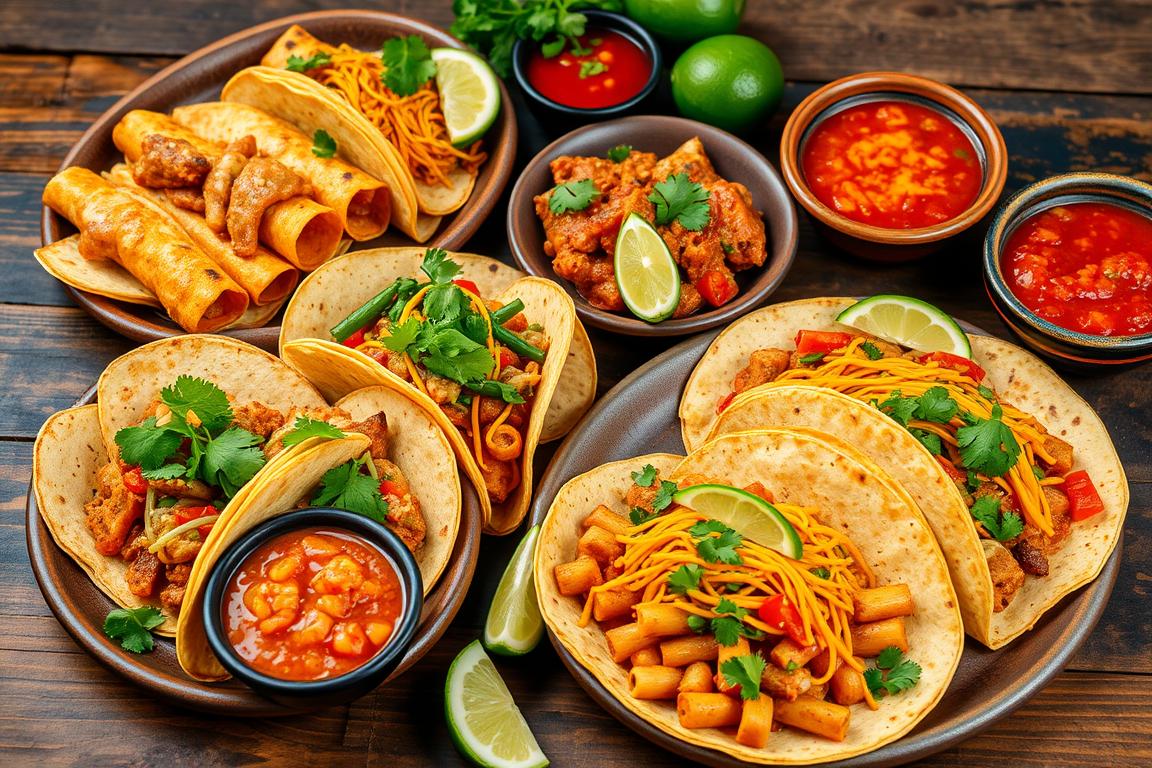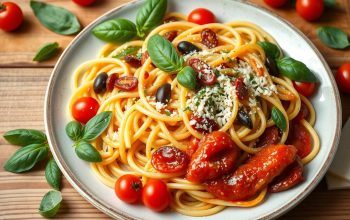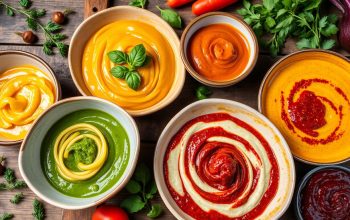Mexican cuisine is a feast for the senses, full of vibrant colors and flavors. It brings joy even on gray days. With its bold colors and enticing smells, it brightens any day.
From rich moles to tangy salsas, Mexican dishes offer a journey of flavors. They take you beyond borders and delight your taste buds.
Mexican cuisine is a mix of traditions, creativity, and history. It started with pre-Hispanic methods and grew with Spanish influences. Today, it’s a unique blend of flavors and techniques.
Looking for something comforting? Try a bowl of steaming pozole. Or maybe a taco with vibrant fillings. Or a slice of creamy flan? Mexican cuisine has it all.
Let’s explore the world of Mexican cuisine together. We’ll discover its history, essential ingredients, and delicious specialties. It’s a journey that will delight your senses.
Introduction to Traditional Mexican Flavors
Mexican cuisine is a colorful mix of flavors from different regions. At its core are the traditional Mexican dishes passed down through generations. These dishes show the rich cultural heritage of this diverse country.
The Essence of Mexican Gastronomy
Mexican food is known for its bold flavors. It combines the smoky taste of chilies with the tangy flavor of citrus. This mix of sweet, sour, spicy, and savory is what makes Mexican dishes special.
Regional Diversity in Mexican Cooking
In Mexico, food varies greatly from one region to another. Coastal areas focus on fresh seafood, while inland places have meat-based dishes. The mole sauces of Oaxaca and the cochinita pibil of the Yucatán are just a few examples of this diversity.
Even as Mexican food evolves, its traditional dishes and regional flavors stay strong. They connect the country’s past to its present and future. Exploring these flavors reveals the essence of Mexican cuisine.
The Heart of Mexican Cuisine: Essential Ingredients
Mexican cuisine is built on a variety of flavorful ingredients. These include the bright red of dried chiles and the rich taste of beans. Together, they create the base of authentic Mexican dishes loved worldwide.
Corn is a key part of Mexican food, used in tortillas, tamales, and tostadas. The ancient method of nixtamalization turns raw corn into nutritious masa. This process adds a special flavor and texture to Mexican dishes.
The variety of chilies is also crucial, from the smoky chipotle to the hot habanero. They add depth and heat to sauces, marinades, and stews. Herbs and spices like cilantro, oregano, and cumin give Mexican food its unique smell.
| Ingredient | Culinary Contribution |
|---|---|
| Corn | Staple grain used in tortillas, tamales, and other dishes |
| Beans | Versatile legume that provides protein and heartiness |
| Tomatoes | Adds vibrant color and acidic notes to sauces and salsas |
| Chiles | Imparts heat and complex flavors to a wide range of dishes |
| Herbs and Spices | Lend aromatic depth and balance to Mexican cuisine |
These mexican ingredients are the heart of authentic mexican recipes. Each one brings its own taste and texture to Mexican food. By using these ingredients, home cooks can truly experience the rich flavors of Mexican cuisine.
From Ancient Times: History of Mexican Culinary Traditions
Mexican cuisine is a rich tapestry woven with the threads of its vibrant past. It spans from ancient times to the Spanish colonial era and the modern gastronomic renaissance. The story of Mexican food is a captivating one that reveals the depths of its cultural heritage.
Pre-Hispanic Cooking Methods
Before the Spanish arrived, indigenous cultures like the Aztecs and the Maya had already developed sophisticated cooking techniques. They mastered the art of nixtamalization, transforming corn into the staple ingredient for tortillas, tamales, and other iconic dishes. They also used clay pots, earth ovens, and techniques like steaming and smoking to create flavorful and nourishing meals.
Spanish Influence on Mexican Food
The Spanish conquest in the 16th century brought a profound transformation to Mexican cuisine. The introduction of European ingredients like rice, wheat, dairy, and a variety of meats blended with the existing indigenous culinary traditions. This fusion of cultures created a gastronomic legacy that continues to evolve and inspire chefs worldwide.
Modern Mexican Gastronomy
In recent decades, Mexican cuisine has experienced a remarkable renaissance. Chefs and food enthusiasts around the world champion its diverse regional specialties and innovative interpretations. From the vibrant street food scene to the refined creations of Michelin-starred restaurants, the Mexican culinary history and Mexican food culture continue to captivate and inspire culinary enthusiasts globally.
“Mexican cuisine is a living, breathing, ever-evolving tradition that celebrates the country’s rich cultural heritage and the boundless creativity of its people.”
Warming Soups and Stews for Cold Weather
When it gets cold, nothing beats a warm bowl of traditional Mexican dishes. Our selection of hearty soups and stews is perfect for those gray, chilly days. They offer a cozy comfort that’s hard to resist.
Pozole is a classic Mexican comfort food. It’s a hominy stew with a rich history. You can find different versions across Mexico, each with its own spices and toppings. From the red to the green, these stews celebrate Mexican culinary heritage.
Menudo is another favorite, a meaty stew with pork, tomatoes, and peppers. It’s a staple in many Mexican homes. The flavors blend together beautifully after hours of simmering.
| Traditional Mexican Dish | Key Ingredients | Regional Variations |
|---|---|---|
| Pozole | Hominy, pork, chiles, herbs | Red, green, white |
| Menudo | Pork, tomatoes, peppers, herbs | Jalisco-style, Sinaloa-style |
| Caldo Tlalpeño | Chicken, vegetables, chickpeas, chipotle | Veracruz-style, Oaxaca-style |
Caldo Tlalpeño is a lighter option. It’s a chicken soup with chickpeas and smoky chipotle. It’s comforting and nourishing for a cold day.
Whether you want the rich pozole or the subtle caldo tlalpeño, these traditional Mexican dishes will warm you up. They bring the authentic flavors of Mexico right to your table. Let these soups and stews take you to a cozy kitchen on a winter’s day.
Vibrant Mexican Street Food Classics
Step into the world of Mexican cuisine and you’ll find a rich mix of regional mexican food traditions. The street food classics are especially fascinating. From the sizzling tacos al pastor in Mexico City to the hearty tlayudas in Oaxaca, these dishes are the heart of Mexican food.
Popular Antojitos
- Tacos: Arguably the most iconic of all Mexican street foods, tacos come in a dizzying variety of fillings, from tender carnitas to zesty al pastor.
- Elotes: Grilled corn on the cob, slathered in a creamy sauce and dusted with cotija cheese and chili powder, is a beloved street food delight.
- Tostadas: These crisp, flat tortillas are the perfect canvas for an array of toppings, from refried beans to shredded chicken and fresh vegetables.
Regional Street Food Variations
Each region of Mexico has its own street food specialties. In the Yucatán, you’ll find the puffed, disc-shaped panuchos. Oaxaca is famous for its tlayudas, oversized crisp tortillas topped with refried beans, cheese, and various meats.
“Street food is an integral part of the Mexican culinary landscape, offering a window into the country’s diverse cultures and traditions.”
Whether you’re walking through Mexico City’s markets or exploring colonial town plazas, trying Mexican street food is a must for food lovers.
Essential Spices and Chilies in Mexican Dishes
Mexican cuisine is all about the spices and chilies. Each adds its own flavor and heat to dishes. From smoky chilies to warm spice blends, these are the core of Mexican cooking.
Discover the wide range of Mexican chilies, from mild ancho to hot habanero. Each chili brings its own taste and heat, making dishes richer and more complex. Learning to use these chilies is key to mastering Mexican cooking.
Spices like cumin, coriander, oregano, and cloves are also vital. They add unique flavors to sauces, marinades, and rubs. The right mix of spices is what makes Mexican dishes taste authentic at home.
| Mexican Chili Variety | Flavor Profile | Heat Level (Scoville Units) |
|---|---|---|
| Ancho | Mild, sweet, and smoky | 1,000 – 1,500 |
| Chipotle | Smoky, earthy, and slightly sweet | 2,500 – 8,000 |
| Habanero | Fruity, floral, and extremely hot | 100,000 – 350,000 |
| Jalapeño | Mildly spicy with a fresh, grassy flavor | 2,500 – 8,000 |
| Pasilla | Fruity, raisin-like, and moderately spicy | 1,000 – 2,500 |
Whether you love Mexican food or just want to try something new, exploring Mexican spices and chilies is exciting. Use these ingredients to bring the real taste of Mexico into your kitchen.
Authentic Mexican Sauces and Salsas
Explore the world of Mexican sauces and salsas. Each bite is a burst of flavors. From moles to pico de gallo, these condiments are the heart of Mexican cooking techniques.
Different Types of Mole
Mole is a labor of love in Mexican cuisine. Each mole has its own unique taste, like Oaxacan mole negro or mole poblano. These sauces mix chilies, spices, nuts, and chocolate for a complex flavor.
Fresh vs Cooked Salsas
- Fresh salsas, like pico de gallo, add a lively touch to authentic Mexican recipes. They mix ripe tomatoes, onions, cilantro, and chilies for a burst of flavor.
- Cooked salsas, like salsa verde, get smoky and tangy on the stove. They blend ingredients into a rich, complex sauce. These sauces add depth to dishes.
Whether you like fresh salsas or cooked sauces, these Mexican cooking techniques will spice up your cooking. They’ll take you on a journey to Mexico’s vibrant streets.
“Sauces and salsas are the beating heart of Mexican cuisine, each one a unique expression of the country’s diverse regional flavors.” – Renowned Mexican chef, Enrique Olvera
Comfort Food: Mexican Rice and Bean Dishes
In the vibrant tapestry of traditional Mexican dishes, rice and beans are key. They are the heart of many comforting meals. These staples are not just sides, but the soul of Mexican cuisine.
Arroz rojo, a tomato-based rice, is a staple in Mexican homes and restaurants. It’s made with onions, garlic, and spices. This vibrant rice pairs well with grilled meats and stews.
Frijoles charros, or cowboy-style beans, are also beloved. They’re slow-cooked with bacon, onions, and spices. These beans are a comforting side dish, often served with rice, tacos, and more.
Refried beans are a classic in Mexican cuisine. They’re creamy and flavorful, perfect for toppings and sides. You can add melted cheese or fresh salsa to them.
“Rice and beans are the foundation of Mexican cuisine, nourishing both the body and the soul.”
These dishes are loved for their comfort and cultural significance. They bring people together at family gatherings and celebrations. Arroz rojo, frijoles charros, and refried beans remind us of the power of simple ingredients to unite us.
Traditional Mexican Cooking Techniques
Exploring Mexico’s rich culinary history, we discover the traditional cooking methods that have shaped its flavors and textures. These include nixtamalization and clay pot cooking. These methods turn simple ingredients into vibrant dishes that excite our senses.
The Nixtamalization Process
Nixtamalization is at the core of Mexican cooking. It dates back to pre-Hispanic times. Corn kernels are cooked and soaked in an alkaline solution, often made from lime or wood ash.
This process boosts corn’s nutrition and brings out its rich, earthy flavors. It’s key to making tamales, tortillas, and sopes, among other dishes.
Clay Pot Cooking Methods
Clay pots are a beloved tradition in Mexican cooking. They’re used for slow-cooking stews and braises. These pots, called ollas, add a unique flavor and tender texture to food.
The clay’s porosity ensures even heat and gentle simmering. This results in dishes like pozole and cocido that are full of earthy essence. Clay pot cooking is a key part of authentic mexican recipes passed down through generations.
Using these traditional mexican cooking techniques, cooks can truly experience Mexican cuisine. Nixtamalization and clay pot cooking are just two ways to bring the vibrant flavors of Mexican heritage into your kitchen.
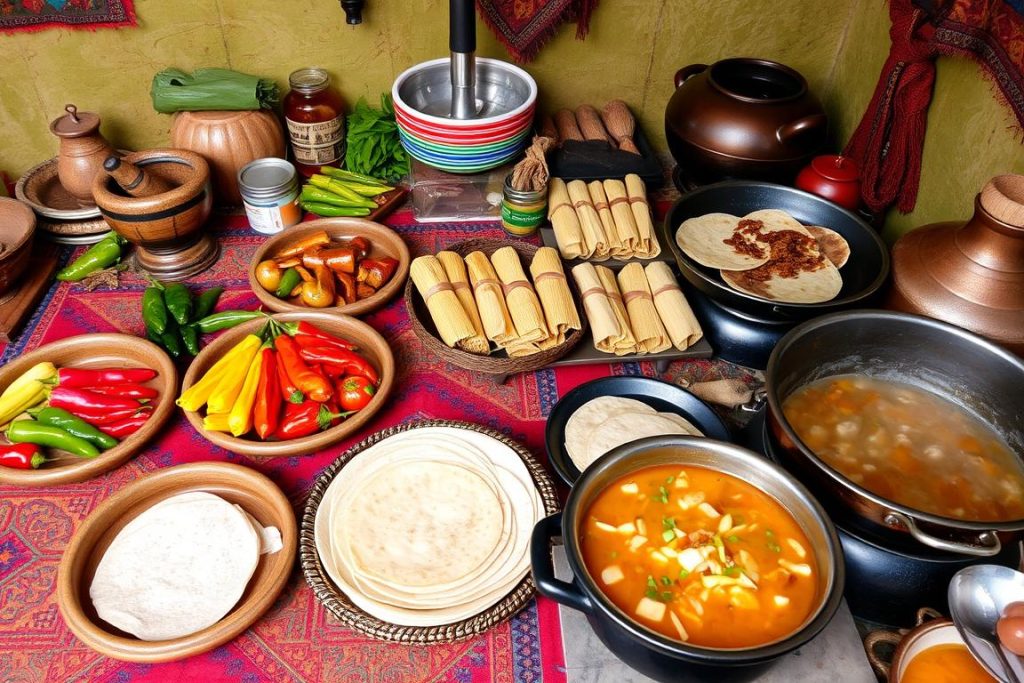
Festive Mexican Main Courses
Step into the vibrant world of traditional Mexican cuisine. Each dish tells a story of rich cultural heritage. From chiles en nogada to cochinita pibil and barbacoa, these dishes are more than meals. They unite communities and honor traditions.
The chiles en nogada is a dish that celebrates Mexico’s independence. It features stuffed poblano peppers, creamy walnut sauce, and pomegranate seeds. This dish captures Mexico’s diverse flavors. The cochinita pibil is a slow-roasted pork from the Yucatán. It’s known for its tenderness and complex taste.
The barbacoa is a beloved Mexican specialty. It’s slow-cooked beef that’s tender and flavorful. This dish shows the ingenuity of Mexican culinary traditions.
Preparing these dishes at home is rewarding. It lets you connect with Mexican food culture. You can bring the flavors of traditional Mexican dishes to your table. With the right ingredients and creativity, you can elevate your dining experience.
| Dish | Description | Typical Occasion |
|---|---|---|
| Chiles en nogada | Stuffed poblano peppers with a creamy walnut sauce and pomegranate seeds | Mexican Independence Day celebrations |
| Cochinita pibil | Slow-roasted pork dish from the Yucatán peninsula, seasoned with achiote, citrus, and spices | Everyday celebrations and family gatherings |
| Barbacoa | Slow-cooked beef dish, typically prepared in underground pits or specialized ovens | Weekends, holidays, and special occasions |
“Mexican cuisine is an expression of the soul of a people; it is their history in the pots.”- Ricardo Muñoz Zurita, renowned Mexican chef and food historian
The Art of Mexican Masa Preparations
Explore the world of masa, a key part of mexican recipes. It’s used in everything from tortillas to tamales. This ingredient is at the heart of mexican cooking techniques. Discover how different regions in Mexico use masa to create unique dishes.
Tamales and Their Variations
Tamales are a favorite in Mexico. They’re made with masa and can be filled with meat, veggies, or even fruit. Each region has its own twist, like the spicy tamales from Oaxaca or the sweet ones from Puebla.
Tortilla Making Techniques
- Mastering the Art of Tortilla Making: See how masa turns into perfect tortillas through hand-patting and griddle-cooking.
- Regional Tortilla Variations: Learn about different tortillas, like the thick ones in the north and the thin ones in the south.
- Nixtamalization: Find out how this ancient method enhances corn’s flavor and nutrition, key to authentic mexican recipes.
Discover the joy of working with masa. Learn the secrets behind Mexico’s favorite dishes. From tortillas to tamales, these mexican cooking techniques will take you to the heart of Mexican cuisine.
| Tamale Fillings | Regional Variations |
|---|---|
| Pork | Oaxacan Tamales |
| Chicken | Tamales de Rajas (Puebla) |
| Vegetables | Tamales de Dulce (Sweet Tamales) |
| Fruit | Tamales Envueltos en Hojas de Plátano (Banana Leaf Tamales) |
| Chocolate | Tamales Oaxaqueños (Oaxacan Tamales) |
Mexican Seafood Specialties
Mexico’s coastlines are home to a rich seafood cuisine. From the Pacific to the Gulf of Mexico, Mexican food traditions celebrate the sea’s bounty. This showcases the amazing variety of traditional Mexican dishes.
Ceviche is a famous dish, made with raw fish marinated in citrus. The acidity “cooks” the fish, adding zesty flavors. It’s often served with onions, chilies, and avocado. Another favorite is pescado a la veracruzana, where fish is cooked in a tangy tomato sauce with olives and herbs.
Camarones al mojo de ajo (shrimp in garlic sauce) is a treat for the taste buds. Succulent shrimp are cooked in a buttery garlic sauce. It’s a dish that will leave you wanting more.
“The diversity of Mexican seafood dishes reflects the country’s vast coastlines and the deep connection its people have with the ocean.”
Every coastal region in Mexico has its own seafood specialties. In the Yucatán, try tikin xic, a fish wrapped in banana leaves. In Baja California, don’t miss the famous fish tacos.
Mexican seafood cuisine celebrates the sea’s bounty. It showcases the country’s rich culinary heritage and its people’s deep connection to the ocean.
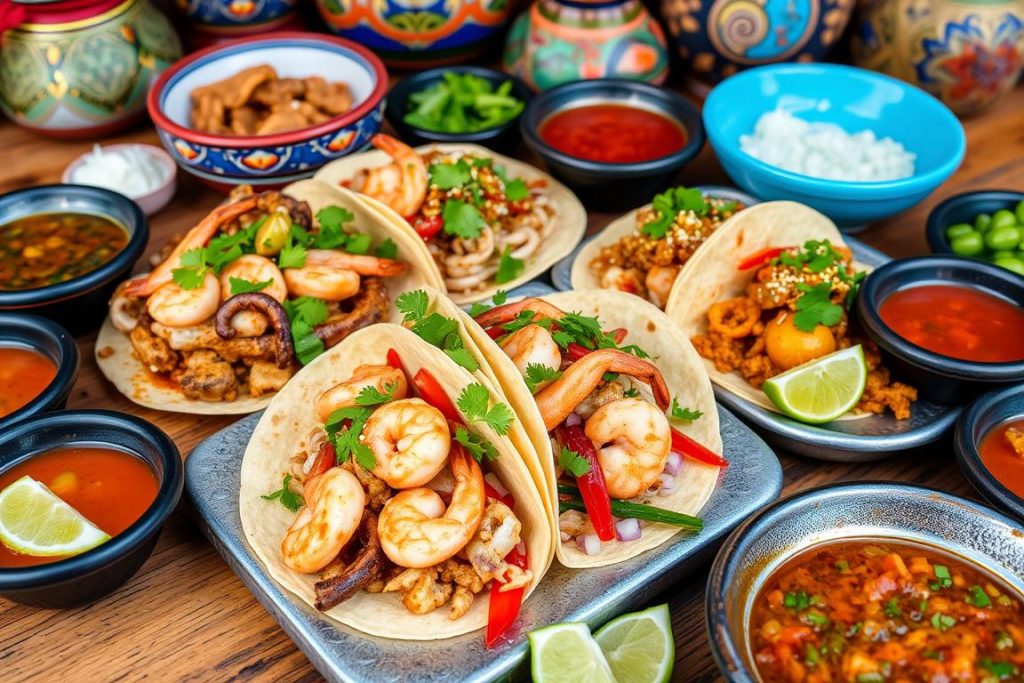
Sweet Endings: Mexican Desserts and Treats
Mexican cuisine is known for its bold flavors, and its desserts are no different. Explore the rich Mexican food traditions and discover the amazing desserts that have been loved for generations.
Traditional Mexican Candies
Mexican candies like cajeta (goat’s milk caramel) and cajeta de membrillo (quince paste) are a treat for the senses. They use local ingredients like piloncillo (unrefined cane sugar) and fruit preserves. This creates a unique taste that is both exciting and delightful.
- Alegría: A crunchy treat made from puffed amaranth, honey, and nuts.
- Jamoncillo de Leche: A smooth, creamy fudge-like candy made with condensed milk.
- Mazapán: A classic peanut-based confection with a texture similar to marzipan.
Festival Sweets and Pastries
Mexican celebrations are filled with delicious pastries and sweets. Churros, with their cinnamon and chocolate, and flan, with its creamy custard, are just a few examples. These treats are a big part of the country’s lively mexican food culture.
| Dessert | Description |
|---|---|
| Churros | Fried dough pastries, often served with a warm chocolate or dulce de leche dipping sauce. |
| Tres Leches Cake | A moist, sponge cake soaked in a mixture of three kinds of milk: evaporated, condensed, and whole milk. |
| Pan Dulce | A wide variety of sweet breads, ranging from flaky conchas to rich, buttery orejas. |
Experience the mexican food traditions by trying the amazing Mexican desserts and treats. From the classic to the modern, these sweet treats are a wonderful way to end a Mexican-inspired meal.
Mexican Beverages: From Aguas Frescas to Hot Drinks
Discover the world of Mexican beverages, where cool aguas frescas and warm hot drinks meet. These drinks showcase the rich culture and flavors of Mexican cuisine. Each one tells a story of tradition and taste.
Begin with horchata, a creamy rice drink with a hint of cinnamon. Then, try atole, a warm corn drink that’s perfect for cold days. For a sweet treat, enjoy Mexican hot chocolate, made with cocoa, cinnamon, and a bit of sugar.
These drinks are key in Mexican culture. They’re enjoyed at celebrations, family dinners, and casual chats. Drinking these authentic drinks will take you straight to the heart of Mexican cuisine.
